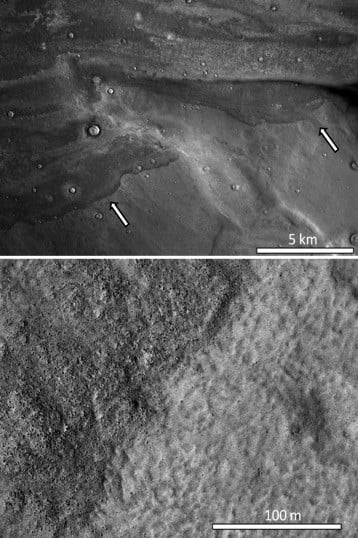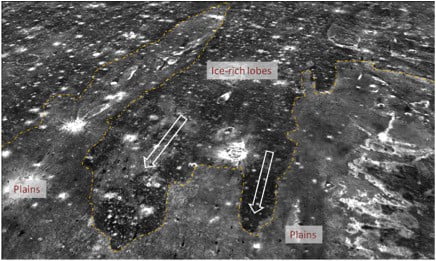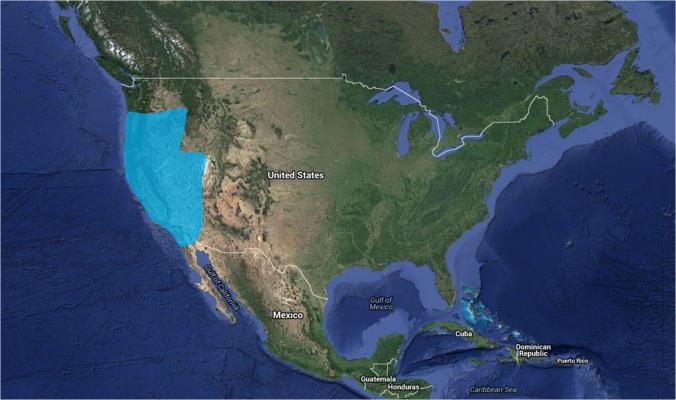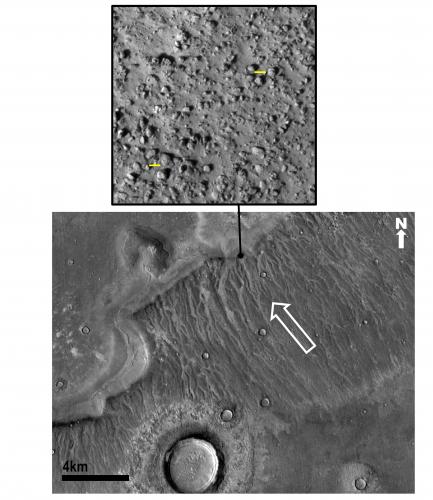New geologic mapping in the Martian northern plains reveals vast sedimentary deposits that were likely emplaced by two mega-tsunamis, according to a new paper in Scientific Reports led by Planetary Science Institute Senior Scientist J. Alexis Palmero Rodriguez.
The proposed tsunami events had onshore wave heights that likely reached as high as 120 meters and moved several hundred kilometers inland.
“For more than a quarter century, failure to identify shoreline features consistently distributed along a constant elevation has been regarded as inconsistent with the hypothesis that a vast ocean existed on Mars approximately 3.4 billion years ago. Our discovery offers a simple solution to this problem; widespread tsunami deposits distributed within a wide range of elevations likely characterize the shorelines of early Martian oceans,” Rodriguez said.
“The tsunamis could have been triggered by bolide impacts, which about every 3 million years, generated marine impact craters approximately 30 kilometers in diameter. Thus, the proposed tsunami events likely took place a few millions years apart,” said PSI Research Scientist and co-author Thomas Platz.
Mega-tsunamis also form on Earth, and their deposits, too, show tremendous variability in their topographic distribution and inundation distances. However, these are extremely rare and catastrophic events, and consequentially their deposits are mostly obscured – or removed – by younger resurfacing processes.
“During the time period that separated the two tsunami events the ocean level receded to form a lower shoreline and the climate became significantly colder. Evidence for climate change is reflected in the morphology of the tsunami deposits. The older tsunami emplaced enormous boulder-rich deposits and as the wave retreated back into the ocean it formed widespread backwash channels,” Rodriguez said.
In contrast, the younger tsunami emplaced lobes that are primarily made of water-ice, he said. Sampling of these materials by future Landers is of particular scientific importance because they likely consist of frozen ancient ocean water brines. Furthermore, these materials are in relatively close proximity to the Mars Pathfinder landing site, demonstrating possible accessibility with current and tested technologies.
The vast areas covered by these ice-rich lobes imply that the frozen remnants of early Mars ocean water might be widespread not just rare and localized occurrences. The fact that many of the lobes have well-defined boundaries and that their flow-related-shapes are not significantly modified suggest that they might still retain much of the originally emplaced materials, which could be informative of the ocean’s primary composition.
“In spite of the extremely cold and dry global climatic conditions, the early Martian ocean likely had a briny composition that allowed it to remain in liquid form for as long as several tens of millions of years. Subfreezing briny aqueous environments are known to be habitable environments on Earth, and consequently, some of the tsunami deposits might be prime astrobiological targets,” said co-author Alberto Fairén, a research scientist at the Center for Astrobiology in Spain, and a visiting scientist in Cornell University’s Department of Astronomy.
“Yet this large expanse of currently documented tsunami inundation is but a portion of what occurred along the margin of the Martian northern plains-filling ocean. Tsunami-related features along other parts of the ocean margin, and potentially other smaller former bodies of water, remain to be identified, mapped and studied in detail,” said co-author Kenneth Tanaka of the U.S. Geological Survey.
“We have already identified some areas inundated by the tsunamis where the ponded water appears to have emplaced lacustrine sediments, including evaporites. As a follow-up investigation we plan to characterize these terrains and assess their potential for future robotic or human in-situ exploration,” Rodriguez said.
Rodriguez and co-author Jianguo Yan of Wuhan University are currently planning an expedition to Tibet to investigate high mountain lakes, in which they have identified landforms developed under extreme environmental conditions that comprise outstanding analogs to features identified within the possible tsunami-generated paleo-lakes.

Visible light images showing older tsunami lobate upper reaches (white arrows) that embay local highland hills. The image below reveals the deposit’s bouldery substrate. Up is towards the bottom right of the images. These images are part of Fig. S3. Lead author Alexis Rodriguez created this figure.

Thermal image showing ice-rich lobes (outlined by yellow line), which we interpret to be the remnants of tsunami waves that transitioned into slurry ice-rich flows as they propagated under extremely cold climatic conditions. Upslope direction of flow indicated by white arrow. The lobe is about 250 km in length, or the distance between Baltimore and New York City. Lead author Alexis Rodriguez created this figure.
*In May 2013, the Saskatchewan Water Security Agency filmed an ice surge in the Codette Reservoir near Nipawin, Saskatchewan, Canada. The surge comprises a spectacular terrestrial analog of rarely observed catastrophic slurry ice-rich flows leading to the emplacement of enormous lobate fronts, which are strikingly similar to those shown in this image; video link: https://www.youtube.com/watch?v=OgMBQFf64JM

Each of the two mapped tsunami deposits has a surface area close to 1 million km2. The image shows the equivalent area over western United States, covering the entire States of California, Nevada and Oregon. Lead author Alexis Rodriguez created this figure.

View of a boulder-rich surface (yellow bars are 10 m) deposited by the older tsunami, and then eroded by channels produced as the tsunami water returned to the ocean elevation level. Lead author Alexis Rodriguez created this figure.
Media Contact
Alan Fischer
Public Information Officer
520-382-0411
[email protected]
Science Contact
J. Alexis Palmero Rodriguez
Senior Scientist
[email protected]
Related Paper
Authors: J. A. P. Rodriguez, A. G. Fairén, K. L. Tanaka, M. Zarroca, R. Linares, T. Platz, G. Komatsu, H. Miyamoto, J. S. Kargel, J. Yan, V. Gulick, K. Higuchi, V. R. Baker, N. Glines
Journal: Scientific Reports
Published: May 19, 2016
DOI: 10.1038/srep25106
Ref: Rodriguez, J. A. P., Fairén, A. G., Tanaka, K. L., et al. “Detection of Possible Mega-tsunami Deposits on Mars Revives Ancient Ocean Hypothesis.” Scientific Reports, 6.25106 (2016).

